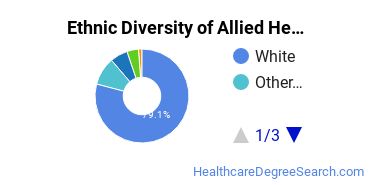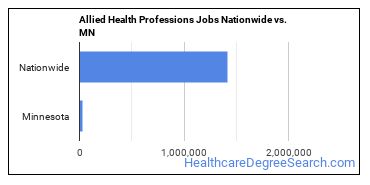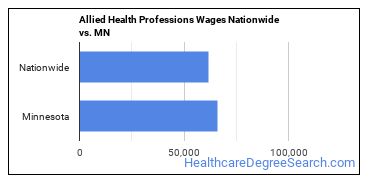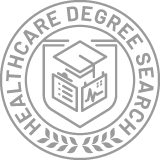Allied Health Professions Schools in Minnesota
In <nil>, 1,066 students earned their Allied Health degrees in MN.
As a degree choice, Allied Health Professions is the 5th most popular major in the state.
Featured schools near , edit
Education Levels of Allied Health Professions Majors in Minnesota
Allied Health majors in the state tend to have the following degree levels:
| Education Level | Number of Grads |
|---|---|
| Associate Degree | 591 |
| Award Taking 1 to 2 Years | 197 |
| Award Taking 2 to 4 Years | 197 |
| Master’s Degree | 170 |
| Bachelor’s Degree | 92 |
| Award Taking Less Than 1 Year | 12 |
| Doctor’s Degree (Research / Scholarship) | 4 |
| Doctor’s Degree (Professional Practice) | 4 |
| Doctor’s Degree (Other) | 4 |
Gender Distribution
In Minnesota, a allied health major is more popular with women than with men.

Racial Distribution
The racial distribution of allied health majors in Minnesota is as follows:
- Asian: 6.8%
- Black or African American: 5.2%
- Hispanic or Latino: 5.3%
- White: 70.6%
- Non-Resident Alien: 0.8%
- Other Races: 11.4%

Jobs for Allied Health Professions Grads in Minnesota
There are 26,970 people in the state and 1,414,230 people in the nation working in allied health jobs.

Wages for Allied Health Professions Jobs in Minnesota
A typical salary for a allied health grad in the state is $66,130, compared to a typical salary of $61,540 nationwide.

Most Popular Allied Health Professions Programs in MN
There are 10 colleges in Minnesota that offer allied health degrees. Learn about the most popular 10 below:
Seeking financial aid? At this school, 99% of students receive it. Students enjoy a student to faculty ratio of 9 to 1. The student loan default rate of 1.50% is a good sign that graduates can afford their loan payments.
The student to faculty ratio is 20 to 1. The full-time teacher rate is 48%. A typical student attending St Cloud Technical and Community College will pay a net price of $9,024.
23 to 1 is the student to faculty ratio. Roughly six years after entering college, graduates of this school earn $38,695 a year. Of all the students who attend this school, 83% get financial aid.
Roughly six years after entering college, graduates of this school earn $32,114 a year. Students enjoy a student to faculty ratio of 19 to 1. This public college charges it's students an average net price of $11,626.
17 to 1 is the student to faculty ratio. The full-time teacher rate is 62%. Seeking financial aid? At this school, 86% of students receive it.
The student loan default rate of 1.10% is a good sign that graduates can afford their loan payments. Grads earn an average early-career salary of $52,654 after earning their degree at this institution. Seeking financial aid? At this school, 99% of students receive it.
Grads earn an average early-career salary of $35,866 after earning their degree at this institution. The full-time teacher rate is 30%. The student to faculty ratio is 18 to 1.
The student to faculty ratio is 10 to 1. The student loan default rate of 0.70% is a good sign that graduates can afford their loan payments. Of all the teachers who work at the school, 50% are considered full time.
The student loan default rate is 3.40% which is lower than average. Graduates earn an average $37,257 after graduation. Seeking financial aid? At this school, 90% of students receive it.
In their early career, St. Cloud State University grads earn an average salary of $45,679. The student loan default rate of 1.50% is a good sign that graduates can afford their loan payments. This public school has an average net price of $14,300.
Allied Health Professions Careers in MN
Some of the careers allied health majors go into include:
| Job Title | MN Job Growth | MN Median Salary |
|---|---|---|
| Physician Assistants | 31% | $115,200 |
| Magnetic Resonance Imaging Technologists | 25% | $77,780 |
| Health Specialties Professors | 21% | $0 |
| Athletic Trainers | 20% | $49,320 |
| Diagnostic Medical Sonographers | 20% | $79,540 |
| Health Technologists and Technicians | 15% | $53,770 |
| Emergency Medical Technicians and Paramedics | 14% | $39,060 |
| Respiratory Therapists | 12% | $68,240 |
| Nuclear Medicine Technologists | 12% | $87,330 |
| Radiation Therapists | 12% | $79,630 |
| Surgical Technologists | 11% | $58,540 |
| Cardiovascular Technologists and Technicians | 9% | $66,230 |
| Occupational Health and Safety Technicians | 5% | $52,130 |
| Respiratory Therapy Technicians | -14% | $0 |
Related Majors in Minnesota
Below are some popular majors in the state that are similar to allied health.
| Major | Annual Graduates in MN |
|---|---|
| Nursing | 14,890 |
| Mental & Social Health Services | 2,487 |
| Health/Medical Admin Services | 2,015 |
| Public Health | 962 |
| Rehabilitation Professions | 603 |
| Bioethics/Medical Ethics | 561 |
| Allied Health Services | 531 |
| Dental Support Services | 461 |
View all majors related to Allied Health Professions
Explore Major by State
Alabama
Arkansas
Connecticut
Florida
Idaho
Iowa
Louisiana
Massachusetts
Mississippi
Nebraska
New Jersey
North Carolina
Oklahoma
Rhode Island
Tennessee
Vermont
West Virginia
View Nationwide Allied Health Professions Report
References
More about our data sources and methodologies.
Featured Schools
 Request Info
Request Info
|
Southern New Hampshire University You have goals. Southern New Hampshire University can help you get there. Whether you need a bachelor's degree to get into a career or want a master's degree to move up in your current career, SNHU has an online program for you. Find your degree from over 200 online programs. Learn More > |





